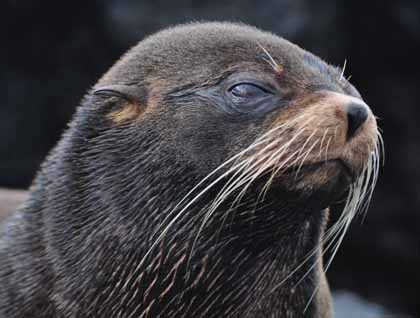Located on the central part of the archipelago, Santiago is also known as San Salvador, named after the first island discovered by Columbus in the Caribbean Sea. It has highlands, beautiful landscapes and incredible endemic creatures that captivated Darwin during his visit to the archipelago in 1835.
We left behind the western realm of Galapagos and after long navigation, we finally arrived to Santiago. Early in the morning we started our first activity, visiting the dark sand beach of Espumilla, which is used by sea turtles for nesting. Sure enough, we found many tracks left by these incredible creatures, which are capable of swimming thousands of miles away and coming back to the same place to lay their eggs. From here we headed into a beautiful mature palo santo forest, where we had time to identify Darwin finches and getting a good close look at a Galapagos hawk. The lush vegetation was no impediment to our enjoyment of the view from a small hill, observing the small lagoon just behind the black beach and the sinuosity of the island, evidence of it volcanism and eruptions that occurred long ago.
After breakfast, the adventure continued with kayaking and snorkeling excursions along the calm waters where a symphony of colors was displayed by many different kinds of tropical fishes, sting rays and playful sea lions. As soon we came back, the National Geographic Endeavour pulled anchored and repositioned to our next destination, Puerto Egas, named in honor to the Egas brothers from Guayaquil city, who extracted salt from an ancient crater and sent it back to the mainland. It is still possible to observe their remains, left as mute witnesses of the last attempt to colonize this island; after that, Santiago Island remained uninhabited.
In the afternoon, we disembarked on a hot and black sandy beach, observing some Galapagos sea lions resting indifferently while our guests photographed them. Farther into the trail that led to the seashore, land birds fluttered among the branches of trees, singing and perching close to us with no fear, including a curious Galapagos fly catcher that landed on the camera of one of our guests. Once we reached the grottos at the farthest point of the trail, we witnessed a colony of fur sea lions that make their homes in the crevices and fissures of the landscape. Throughout the crystalline and turquoise waters, sea turtles and colorful fish could be seen swimming around the perimeter of this unique place. We walked along the coastal zone, the landscape changing dramatically with spectacular tidal pools full of marine iguanas warming their bodies. Closer to the coastline we observed shorebirds like American oystercatchers, herons, whimbrels and sanderlings.
Along the west, Isabela Island looked spectacular, and we could even look past it to see Fernandina Island. The sunset was picturesque, illuminating the mountains while sea birds flew freely through the air, and lava lizards accompanied us on the path as we returned to the black beach, as if saying good bye, after an incredible day in the Enchanted Islands.







